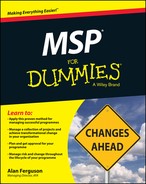Chapter 21
Closing a Programme
In This Chapter
![]() Recognising the right time to close your programme
Recognising the right time to close your programme
![]() Understanding the closure process
Understanding the closure process
Everything comes to an end (though The Archers radio show is making a good stab at immortality), and at some point your programme needs to be closed.
If you've been part of the management team of a programme for three or four years and it's reaching the end of its last tranche, you need only a little advice on how to close your programme. No doubt you're already an expert on subjects such as your stakeholders, benefits and the outcomes (if not, check out Chapters 14, 15 and 16, respectively). Therefore, this chapter comprises just a few short checklists of some of the activities you may need to do when closing your programme.
I also reflect on when to close a programme (it's certainly not as simple as when the last project finishes), including the different circumstances in which you need to close a programme prematurely.
Knowing When to Close the Programme
- Recognising formally the delivery of new capabilities as defined in the Blueprint.
- Reviewing formally the assessment of outcomes via benefit measures, and identifying the need for future assessments of benefits realization.
In essence, you can close the programme when benefits realization is embedded in business as usual.
Considering closure circumstances
In this section I describe the precise circumstances in which you close the programme in a planned way. You carry out closure when:
- Changes have been delivered.
- Business operations have stabilised.
- Benefit measures are underway and embedded in business as usual.
Some of the tests you can apply to decide whether closure is appropriate are as follows:
- Is the Blueprint being delivered?
- Have the outcomes been achieved?
- Is the Business Case satisfied?
- Are benefits self-sustaining?
- Has the last tranche been completed?
- Have outstanding risks and issues been transferred to business as usual?
Managing benefits after the end of your programme
You need to continue benefits management after the end of the programme. Benefits take quite a time to materialise and may not have reached the target levels mentioned in documents such as the Benefits Realization Plan as the programme nears its close. New benefits continue to appear. Recording those unexpected benefits may be useful, particularly if the organization is going to run other programmes. Recording them means creating new Benefit Profiles so that other programmes can look at how those benefits accumulated.
The Business Change Managers are responsible for realizing these benefits, but they stop calling themselves Business Change Managers when the programme ends: they just have their business-as-usual roles and job titles.
Here are some guidelines on when the programme finishes officially:
- Certainly some time after the delivery of the last capability.
- After the benefits settle down.
- When the benefits reach previously agreed levels.
No doubt in your programme the circumstances in which your programme closes is something you need to discuss at length.
Closing a programme prematurely
In all the following circumstances you need to carry out a premature closure of your programme:
- Evidence indicates that the programme no longer has a viable Business Case.
- The organization can no longer secure funding or resources for the programme.
- External circumstances have changed so significantly that the programme is no longer valid.
Closing Down a Programme: The Process
In this section I look in detail at the programme closure process (check out Figure 21-1 for an overview).

Copyright © AXELOS Limited 2011 Reproduced under licence from AXELOS
Figure 21-1: Closing a Programme.
Inputs
You need to consider some fairly straightforward inputs, illustrated in Figure 21-1, as follows:
- The management, boundary and governance document baselines.
- An assurance review is necessary at the end of the programme, so you need an assurance review report and an end-of-tranche review.
- If the programme has been closed prematurely, you may need to input the reasons for closure.
- Ensure that lessons are learnt.
- Consider any warranties, as necessary.
Principal controls
Again looking at Figure 21-1, the principal controls are pretty straightforward. The Sponsoring Group has to authorise closure. Any other controls that were specified in the governance document baselines also have to be carried out. Probably this includes a formal assurance review of the programme; the reasons for closure may in themselves be a type of control as well.
Key roles and responsibilities
The focus of the roles and responsibilities in this process is back up at the senior level that initially identified the programme and that's reflected in the key roles.
The activities themselves are a pretty straightforward checklist:
- Confirm on-going support.
- Confirm programme closure.
- Notify stakeholders that the programme is about to close.
- Review programme.
- Update and finalise information.
- Feedback to policy and strategy.
- Disband programme organization and support functions.
Responsibilities are spread around rather more than in many processes:
- The SRO is naturally accountable for all the activities.
- The Programme Manager is responsible for all the activities in Closing a Programme with the following exceptions:
- The SRO only consults with others before confirming closure.
- The Business Change Managers are responsible for reviewing the programme.
Outputs
The outputs shown In Figure 21-1 are the sorts of closure disbandment items that you'd expect:
- Confirmations
- Handovers
- Notifications

 The purpose of the Closing a Programme stage is to ensure that you've maintained focus on achieving the end-goal, which means:
The purpose of the Closing a Programme stage is to ensure that you've maintained focus on achieving the end-goal, which means: You may not have achieved all the benefits from the programme when you close it. You (which ultimately means the SRO) can close the programme when you can demonstrate sufficient benefits realization and the Sponsoring Group is reassured that benefits will continue to be realized (benefits are likely to continue for a long time, well after the end of the programme).
You may not have achieved all the benefits from the programme when you close it. You (which ultimately means the SRO) can close the programme when you can demonstrate sufficient benefits realization and the Sponsoring Group is reassured that benefits will continue to be realized (benefits are likely to continue for a long time, well after the end of the programme). Be careful in a programme not to create contracts that are with the programme, because when it finishes those contracts are no longer valid. So, you need to carry out a little bit of contract management as well.
Be careful in a programme not to create contracts that are with the programme, because when it finishes those contracts are no longer valid. So, you need to carry out a little bit of contract management as well.